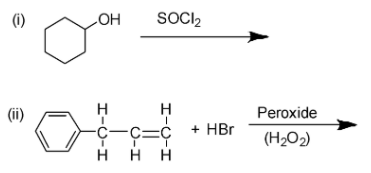
Answer
420.6k+ views
Hint: If one or more of the hydrogen atoms are being replaced by an equivalent number of the halogens in a hydrocarbon, the final compounds attained are known as halogen derivatives of hydrocarbons.
Complete step-by-step answer:
Depending on the number of halogen atoms in the halogen derivatives of hydrocarbons are known as monohalogen or polyhalogen derivatives of hydrocarbons. Let us draw the structure of a major monohalo product by completing each of the given reactions one by one.
(i) \[SOC{l_2}\]i.e. thionyl chloride is generally used to prepare alkyl chlorides from alcohols. In the given reaction, cyclohexanol is made to react with thionyl chloride. The hydroxyl oxygen (of cyclohexanol) attacks the electrophilic Sulfur (of thionyl chloride) which leads to the formation of chlorosulfite ester (cyclohexyl sufurochloridite) and hydrogen chloride. The chlorosulfite ester then rearranges with the breaking of C-O and S-Cl bonds and leads to the formation of chlorocyclohexane and sulphur dioxide. The reaction is depicted below:

(ii) Addition reaction of allyl benzene in the presence of peroxide generally yields (3-bromopropyl)benzene in accordance with anti-Markovnikov rule of addition. According to anti-Markovnikov rule, the hydrogen atom of HX in an addition reaction of generic electrophile HX to either an alkene or alkyne, becomes bonded to carbon atom having the least number of hydrogen atoms in the starting alkyne or alkene. The reaction is depicted below:

Note: The major difference between Markovnikov and anti-Markovnikov rule is that Markinov rule states that in an addition reaction, hydrogen atoms are linked to the carbon atom having more hydrogen substituents while anti-Markovnikov rule states that in an addition reaction, hydrogen atoms are linked to the carbon atom having the least hydrogen substituents.
Complete step-by-step answer:
Depending on the number of halogen atoms in the halogen derivatives of hydrocarbons are known as monohalogen or polyhalogen derivatives of hydrocarbons. Let us draw the structure of a major monohalo product by completing each of the given reactions one by one.
(i) \[SOC{l_2}\]i.e. thionyl chloride is generally used to prepare alkyl chlorides from alcohols. In the given reaction, cyclohexanol is made to react with thionyl chloride. The hydroxyl oxygen (of cyclohexanol) attacks the electrophilic Sulfur (of thionyl chloride) which leads to the formation of chlorosulfite ester (cyclohexyl sufurochloridite) and hydrogen chloride. The chlorosulfite ester then rearranges with the breaking of C-O and S-Cl bonds and leads to the formation of chlorocyclohexane and sulphur dioxide. The reaction is depicted below:

(ii) Addition reaction of allyl benzene in the presence of peroxide generally yields (3-bromopropyl)benzene in accordance with anti-Markovnikov rule of addition. According to anti-Markovnikov rule, the hydrogen atom of HX in an addition reaction of generic electrophile HX to either an alkene or alkyne, becomes bonded to carbon atom having the least number of hydrogen atoms in the starting alkyne or alkene. The reaction is depicted below:

Note: The major difference between Markovnikov and anti-Markovnikov rule is that Markinov rule states that in an addition reaction, hydrogen atoms are linked to the carbon atom having more hydrogen substituents while anti-Markovnikov rule states that in an addition reaction, hydrogen atoms are linked to the carbon atom having the least hydrogen substituents.
Recently Updated Pages
How many sigma and pi bonds are present in HCequiv class 11 chemistry CBSE

Mark and label the given geoinformation on the outline class 11 social science CBSE

When people say No pun intended what does that mea class 8 english CBSE

Name the states which share their boundary with Indias class 9 social science CBSE

Give an account of the Northern Plains of India class 9 social science CBSE

Change the following sentences into negative and interrogative class 10 english CBSE

Trending doubts
Fill the blanks with the suitable prepositions 1 The class 9 english CBSE

Give 10 examples for herbs , shrubs , climbers , creepers

Change the following sentences into negative and interrogative class 10 english CBSE

Difference between Prokaryotic cell and Eukaryotic class 11 biology CBSE

The Equation xxx + 2 is Satisfied when x is Equal to Class 10 Maths

How do you graph the function fx 4x class 9 maths CBSE

Differentiate between homogeneous and heterogeneous class 12 chemistry CBSE

Application to your principal for the character ce class 8 english CBSE

Write a letter to the principal requesting him to grant class 10 english CBSE




